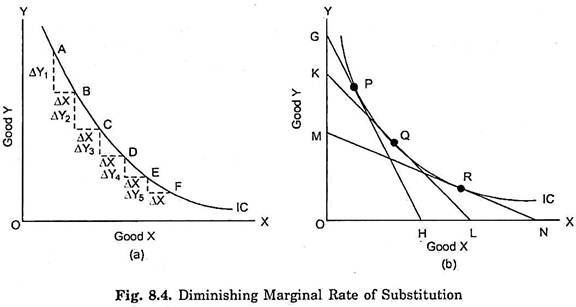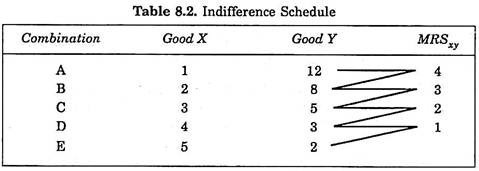An important principle of economic theory is that marginal rate of substitution of X for Y diminishes as more and more of good X is substituted for good Y. In other words, as the consumer has more and more of good X, he is prepared to forego less and less of good Y. The principle of diminishing marginal rate of substitution is illustrated in Fig. 8.4. in Fig. 8.4 (a) when the consumer slides down from A to B on the indifference curve he gives up AY1 of good Y for the compensating gain of ΔX of good X.
Therefore, the marginal rate of substitution (MRSxy) is here equal to ΔY1/ΔX. But as the consumer further slides down on the curve, the length ΔY becomes shorter and shorter, while the length ΔX is kept the same. It will thus be seen from Fig. 8.4 (a) that ΔY2 is less than ΔY1; ΔY3 is less than ΔY2; and ΔY4 is less than ΔY3.
It means that as the consumer’s stock of X increases and his stock of Y decreases, he is willing to forego less and less of Y for a given increment in X. In other words, the marginal rate of substitution of X for Y falls as the consumer has more of X and less of Y. That the marginal rate of substitution of X for Y diminishes can also be known from drawing tangents at different points on an indifference curve.
The marginal rate of substitution at a point on the indifference curve is equal to the slope of the indifference curve at that point and can therefore be found out by ate tangent of the angle which the tangent line made with the X-axis. In Fig. 8.4 (b) three tangents GH, KL and MN are drawn at the points P, Q and R respectively on the given indifference curve.
ADVERTISEMENTS:
Slope of the tangent GH is equal to OG/OH. Hence, the marginal rate of substitution of X for Y at point P is equal to OG/OH. Likewise, the marginal rate of substitution at point Q is equal OK/OL and at point R is equal to OM/ON. It will be noticed that OK/OL, is smaller than OG/OH and OM/ON is smaller than OK/OL. It follows that MRSxy diminishes as the consumer slides down on his indifference curve.
That the marginal rate of substitution falls is also evident from the Table 8.2. In the beginning the marginal rate of substitution of X for Y is 4 and as more and more of X is obtained and less and less of Y is left, the MRSxy keeps on falling. Between B and C it is 3; between C and D, it is 2; and finally between D and E, it is 1.
Now, the question is what accounts for the diminishing marginal rate of substitution. In other words, why is it that the consumer is willing to give up less and less of Y for a given increment in X as he slides down on the curve?
ADVERTISEMENTS:
The following three factors are responsible for diminishing marginal rate of substitution:
First, the want for a particular good is satiable so that as the consumer has more and more of a good the intensity of his want for that good goes on declining. It is because of this fall in the intensity of want for a good, say X, that when its stock increases with the consumer, he is prepared to forego less and less of good Y for every increment in X.
In the beginning, when the consumer’s stock of good Y is relatively large and his stock of good X is relatively small, consumer’s marginal significance for good Y is low, while his marginal significance for good X is high. Owing to higher marginal significance of good X and lower marginal significance of good Y in the beginning the consumer will be willing to give up a larger amount of Y for a unit increase in good X.
ADVERTISEMENTS:
But as the stock of good X increases and intensity of desire for it falls, his marginal significance of good X will diminish and on the other hand, as the stock of good Y decreases and the intensity of desire for it increases, his marginal significance for good Y will go up. As a result, therefore, as the individual substitutes more and more of X for Y, he is prepared to give up less and less of Y for a unit increase in X.
The second reason for the decline in marginal rate of substitution is that the goods are imperfect substitutes of each other. If two goods are perfect substitutes of each other, then they are to be regarded as one and the same good, and therefore increase in the quantity of one and decrease in the quantity of the other would not make any difference in the marginal significance of the goods. Thus, in case of perfect substitutability of goods, the increase and decrease will be virtually in the same good which cancel out each other and therefore the marginal rate of substitution remains the same and does not decline.
Thirdly, the principle of diminishing marginal rate of substitution will hold good only if the increase in the quantity of one good does not increase the want satisfying power of the other. If with the increase in the stock of good X, the want satisfying power of good increases, then greater and greater amount of good Y will be required to be given up for a unit increase in good X so that consumer’s satisfaction remains the same.

